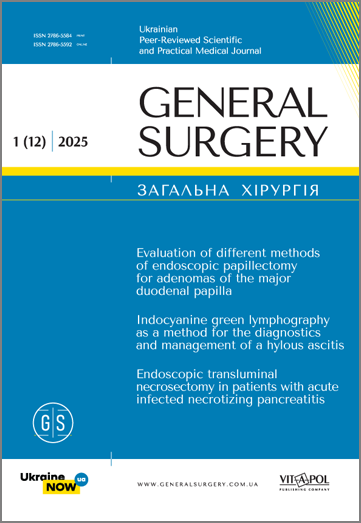Endoscopic transluminal necrosectomy in patients with acute infected necrotizing pancreatitis. Experience of a specialized center
DOI:
https://doi.org/10.30978/GS-2025-1-50Keywords:
acute pancreatitis, acute infected necrotizing pancreatitis, walled‑off pancreatic necrosis, endoscopic transluminal necrosectomy, direct endoscopic necrosectomyAbstract
Over the past decades, the treatment of acute infected necrotizing pancreatitis (AINP) has significantly improved due to a better understanding of the disease pathogenesis and the implementation of minimally invasive technologies. Endoscopic transluminal interventions occupy an important place among these techniques and continue to evolve, both technically and tactically.
Objective – to evaluate the results of ETN in the treatment of patients with acute infected necrotizing pancreatitis (AINP) and summarize the experience of our department, including technical and tactical aspects of the procedure.
Materials and methods. The study included 28 patients: 15 (53.6%) men and 13 (46.4%) women with a mean age of 52.6±12.5 years, who underwent ETN between 2021 and 2024 due to a limited peri‑/pancreatic necrotic collection in direct contact with the stomach and/or duodenum. AINP of moderate severity was diagnosed in 19 (67.9%) patients, and a severe course – in 9 (32.1%). The mean size of the walled‑off pancreatic necrosis (WON) was 109.6±32.9 mm. ETN outcomes were assessed as complete, partial, or no clinical success.
Results. The first ETN session was performed on average on day 36.2±16.1 (range: 22 to 86 days) from the onset of the disease. A total of 48 ETN sessions were performed, from 1 to 4 per patient, most often a single session in 14 (50.0%) patients. The intervals between subsequent sessions were mostly 6 – 7 days. Continuous lavage of the WON cavity was performed in 17 (60.7%) patients. The duration of each procedure ranged from 60 to 90 minutes. The rate of intraoperative complications was 3.6% (n=1, profuse bleeding). Complete clinical success was achieved in 18 (64.3%) patients, partial success – in 8 (28.6%), and no clinical success – in 2 (7.1%) patients. Overall, 25 (89.3%) patients recovered, and the mortality rate was 10.7% (3 cases).
Conclusions. In 64.3% of cases, ETN can be the main treatment method in AINP when the indications for the procedure are observed. In 28.6% of patients, it serves as a transitional stage before more invasive surgical procedures. Performing ETN with subsequent continuous lavage of the WON cavity increases the likelihood of achieving complete clinical success by 2.26 times compared to patients without lavage (RR 2.26; 95% CI 1.01 – 5.10; p=0.0485).
References
Arvanitakis M, Dumonceau JM, Albert J, Badaoui A, Bali MA, Barthet M, Besselink M, Deviere J, Oliveira Ferreira A, Gyökeres T, Hritz I, Hucl T, Milashka M, Papanikolaou IS, Poley JW, Seewald S, Vanbiervliet G, van Lienden K, van Santvoort H, Voermans R, Delhaye M, van Hooft J. Endoscopic management of acute necrotizing pancreatitis: European Society of Gastrointestinal Endoscopy (ESGE) evidence-based multidisciplinary guidelines. Endoscopy. 2018 May;50(5):524-546. http://doi.org/10.1055/a-0588-5365. Epub 2018 Apr 9. PMID: 29631305.
Banks PA, Bollen TL, Dervenis C, Gooszen HG, Johnson CD, Sarr MG, Tsiotos GG, Vege SS; Acute Pancreatitis Classification Working Group. Classification of acute pancreatitis-2012: revision of the Atlanta classification and definitions by international consensus. Gut. 2013 Jan;62(1):102-11. http://doi.org/10.1136/gutjnl-2012-302779. Epub 2012 Oct 25. PMID: 23100216.
Bugiantella W, Rondelli F, Boni M, Stella P, Polistena A, Sanguinetti A, Avenia N. Necrotizing pancreatitis: A review of the interventions. Int J Surg. 2016 Apr;28 Suppl 1:S163-71. http://doi.org/10.1016/j.ijsu.2015.12.038. Epub 2015 Dec 18. PMID: 26708848.
Freeman ML, Werner J, van Santvoort HC, Baron TH, Besselink MG, Windsor JA, Horvath KD, vanSonnenberg E, Bollen TL, Vege SS; International Multidisciplinary Panel of Speakers and Moderators. Interventions for necrotizing pancreatitis: summary of a multidisciplinary consensus conference. Pancreas. 2012 Nov;41(8):1176-94. http://doi.org/10.1097/MPA.0b013e318269c660. PMID: 23086243.
Kahaleh M, Shami VM, Conaway MR, Tokar J, Rockoff T, De La Rue SA, de Lange E, Bassignani M, Gay S, Adams RB, Yeaton P. Endoscopic ultrasound drainage of pancreatic pseudocyst: a prospective comparison with conventional endoscopic drainage. Endoscopy. 2006 Apr;38(4):355-9. http://doi.org/10.1055/s-2006-925249. PMID: 16680634.
Papachristou GI, Takahashi N, Chahal P, Sarr MG, Baron TH. Peroral endoscopic drainage/debridement of walled-off pancreatic necrosis. Ann Surg. 2007 Jun;245(6):943-51. http://doi.org/10.1097/01.sla.0000254366.19366.69. PMID: 17522520; PMCID: PMC1876949.
Seifert H, Biermer M, Schmitt W, Jürgensen C, Will U, Gerlach R, Kreitmair C, Meining A, Wehrmann T, Rösch T. Transluminal endoscopic necrosectomy after acute pancreatitis: a multicentre study with long-term follow-up (the GEPARD Study). Gut. 2009 Sep;58(9):1260-6. http://doi.org/10.1136/gut.2008.163733. Epub 2009 Mar 11. PMID: 19282306.
Seifert H, Wehrmann T, Schmitt T, Zeuzem S, Caspary WF. Retroperitoneal endoscopic debridement for infected peripancreatic necrosis. Lancet. 2000 Aug 19;356(9230):653-5. http://doi.org/10.1016/S0140-6736(00)02611-8. PMID: 10968442.
Sousa D, Freitas Ferreira AC, Raimundo P, Maio R. Walled-off pancreatic necrosis: a staged multidisciplinary step-up approach. BMJ Case Rep. 2020 Mar 26;13(3):e232952. http://doi.org/10.1136/bcr-2019-232952. PMID: 32221010; PMCID: PMC7167482.
Van Santvoort HC, Besselink MG, Bakker OJ, Hofker HS, Boermeester MA, Dejong CH, van Goor H, Schaapherder AF, van Eijck CH, Bollen TL, van Ramshorst B, Nieuwenhuijs VB, Timmer R, Laméris JS, Kruyt PM, Manusama ER, van der Harst E, van der Schelling GP, Karsten T, Hesselink EJ, van Laarhoven CJ, Rosman C, Bosscha K, de Wit RJ, Houdijk AP, van Leeuwen MS, Buskens E, Gooszen HG; Dutch Pancreatitis Study Group. A step-up approach or open necrosectomy for necrotizing pancreatitis. N Engl J Med. 2010 Apr 22;362(16):1491-502. http://doi.org/10.1056/NEJMoa0908821. PMID: 20410514.
Working Group IAP/APA Acute Pancreatitis Guidelines. IAP/APA evidence-based guidelines for the management of acute pancreatitis. Pancreatology. 2013 Jul-Aug;13(4 Suppl 2):e1-15. http://doi.org/10.1016/j.pan.2013.07.063. PMID: 24054878.
Zeng Y, Yang J, Zhang JW. Endoscopic transluminal drainage and necrosectomy for infected necrotizing pancreatitis: Progress and challenges. World J Clin Cases. 2023 Mar 26;11(9):1888-1902. http://doi.org/10.12998/wjcc.v11.i9.1888. PMID: 36998953; PMCID: PMC10044952.
Downloads
Published
How to Cite
Issue
Section
License
Copyright (c) 2025 Authors

This work is licensed under a Creative Commons Attribution-NoDerivatives 4.0 International License.






